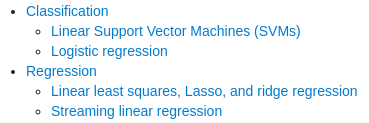[ML] Online learning
复习
一、Spark 流处理
使用Spark Streaming与我们操作RDD的方式很接近,处理数据流也变得简单了。使用Spark的流处理元素结合MLlib的基于SGD的在线学习能力,可以创建实时的机器学习模型,当数据流到达时实时更新学习模型。
[Spark] 04 - What is Spark Streaming
[Spark] 06 - Structured Streaming
[Link] http://shartoo.github.io/spark-python-example/ [若干有用例子]
二、Spark.ml 库

三、本地模式下的 "在线学习"
[Scikit-learn] 1.5 Generalized Linear Models - SGD for Regression
[Scikit-learn] 1.5 Generalized Linear Models - SGD for Classification
[Scikit-learn] 1.1 Generalized Linear Models - Comparing online solvers
学习
一、批计算
例如:LinearRegressionWithSGD
SGD相关算法:
Algorithms are all implemented in Scala: 这些个都是只存在于mllib中的api。
-
- SVMWithSGD
- LogisticRegressionWithLBFGS
- LogisticRegressionWithSGD
- LinearRegressionWithSGD
- RidgeRegressionWithSGD
- LassoWithSGD
- GeneralizedLinearRegression [spark.ml]
二、流计算
StreamingLinearRegressionWithSGD(...)
Train or predict a linear regression model on streaming data. Training uses Stochastic Gradient Descent to update the model based on each new batch of incoming data from a DStream (see LinearRegressionWithSGD for model equation).
Each batch of data is assumed to be an RDD of LabeledPoints. The number of data points per batch can vary, but the number of features must be constant. An initial weight vector must be provided.
Ref: How does Spark's StreamingLinearRegressionWithSGD work?
spark.ml是否有对应api的问题,只能通过阅读源代码才能一探究竟了。
三、流聚类模型
Ref: Spark机器学习9· 实时机器学习(scala with sbt)
电子书下载:https://www.iteblog.com/download/2150.html
代码下载:https://github.com/PacktPublishing/Machine-Learning-with-Spark-Second-Edition
Chapter 1: Getting Up and Running with SparkChapter 2: Math for Machine LearningChapter 3: Designing a Machine Learning SystemChapter 4: Obtaining, Processing, and Preparing Data with SparkChapter 5: Building a Recommendation Engine with SparkChapter 6: Building a Classification Model with SparkChapter 7: Building a Regression Model with SparkChapter 8: Building a Clustering Model with SparkChapter 9: Dimensionality Reduction with SparkChapter 10: Advanced Text Processing with SparkChapter 11: Real-Time Machine Learning with Spark StreamingChapter 12: Pipeline APIs for Spark ML |
Vectors.dense
稀疏格式表示为(4,[0,2,3],[1.0,1.0,3.0]) 第一个4表示向量的长度(元素个数),[0,2,3]就是indices数组,[1.0,1.0,3.0]是values数组,表示向量0的位置的值是1.0,2的位置的值是1.0,而3的位置的值是3.0,其他的位置都是0。
LabeledPoint
//创建一个标签为1.0(分类中可视为正样本)的稠密向量标注点 scala> val pos = LabeledPoint(1.0, Vectors.dense(2.0, 0.0, 8.0)) pos: org.apache.spark.mllib.regression.LabeledPoint = (1.0,[2.0,0.0,8.0])
//创建一个标签为0.0(分类中可视为负样本)的稀疏向量标注点 scala> val neg = LabeledPoint(0.0, Vectors.sparse(3, Array(0, 2), Array(2.0, 8.0))) neg: org.apache.spark.mllib.regression.LabeledPoint = (0.0, (3,[0,2],[2.0,8.0]))
Spark Streaming 使用 streamingContext.queueStream(queueOfRDDs) 方法可以创建基于 RDD 队列的DStream,每个RDD 队列将被视为 DStream 中一块数据流进行加工处理。
trainOn, update the model by training on batches of data from a DStream. This operation registers a DStream for training the model, and updates the model based on every subsequent batch of data from the stream.
Init¶
from pyspark import SparkConf, SparkContext
from pyspark.sql import SparkSession
from pyspark.streaming import StreamingContext
import datetime
def fnGetAppName():
currentSecond=datetime.datetime.now().second
currentMinute=datetime.datetime.now().minute
currentHour=datetime.datetime.now().hour
currentDay=datetime.datetime.now().day
currentMonth=datetime.datetime.now().month
currentYear=datetime.datetime.now().year
return "{}-{}-{}_{}-{}-{}".format(currentYear, currentMonth, currentDay, currentHour, currentMinute, currentSecond)
def fn_timer(a_func):
def wrapTheFunction():
import time
time_start=time.time()
a_func()
time_end=time.time()
print('totally cost {} sec'.format(time_end-time_start))
return wrapTheFunction
appName = fnGetAppName()
print("appName: {}".format(appName))
conf = SparkConf().setMaster("spark://node-master:7077").setAppName(appName)
# conf = SparkConf().setMaster("local").setAppName(appName)
Spark Context¶
sc = SparkContext(conf = conf)
Spark Session¶
spark = SparkSession.builder.config(conf=SparkConf()).getOrCreate()
Spark Stream¶
ssc = StreamingContext(sc, 1)
Let's Go!¶
from __future__ import print_function
# $example on$
from pyspark.mllib.linalg import Vectors
from pyspark.mllib.regression import LabeledPoint
from pyspark.mllib.clustering import StreamingKMeans
# $example off$
# $example on$
# we make an input stream of vectors for training,
# as well as a stream of vectors for testing
def parse(lp):
label = float(lp[lp.find('(') + 1: lp.find(')')])
vec = Vectors.dense(lp[lp.find('[') + 1: lp.find(']')].split(','))
return LabeledPoint(label, vec)
# (1)
trainingData = sc.textFile("/test/kmeans_data.txt")\
.map(lambda line: Vectors.dense([float(x) for x in line.strip().split(' ')]))
testingData = sc.textFile("/test/streaming_kmeans_data_test.txt").map(parse)
# (2)
trainingQueue = [trainingData]
testingQueue = [testingData]
# rdd队列流,作为模型的“参数”
# More details: [Spark] 04 - What is Spark Streaming
# (3)
trainingStream = ssc.queueStream(trainingQueue)
testingStream = ssc.queueStream(testingQueue)
# We create a model with random clusters and specify the number of clusters to find
model = StreamingKMeans(k=2, decayFactor=1.0).setRandomCenters(3, 1.0, 0)
# Now register the streams for training and testing and start the job,
# printing the predicted cluster assignments on new data points as they arrive.
# (4)
model.trainOn(trainingStream)
result = model.predictOnValues(testingStream.map(lambda lp: (lp.label, lp.features)))
result.pprint()
ssc.start()
ssc.stop(stopSparkContext=True, stopGraceFully=True)
# $example off$
print("Final centers: " + str(model.latestModel().centers))
四、流回归模型
实践代码:
/* implement */




 浙公网安备 33010602011771号
浙公网安备 33010602011771号